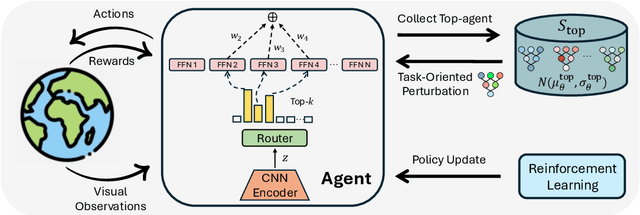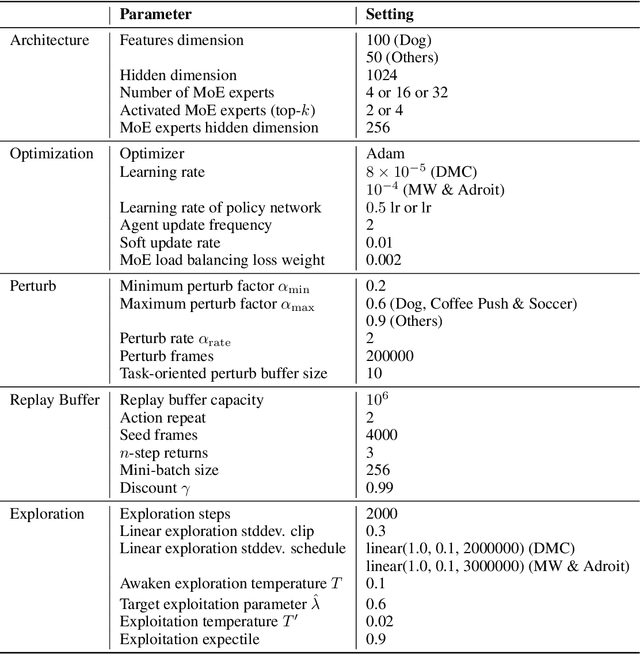Huazhe Xu
Two by Two: Learning Multi-Task Pairwise Objects Assembly for Generalizable Robot Manipulation
Apr 09, 2025Abstract:3D assembly tasks, such as furniture assembly and component fitting, play a crucial role in daily life and represent essential capabilities for future home robots. Existing benchmarks and datasets predominantly focus on assembling geometric fragments or factory parts, which fall short in addressing the complexities of everyday object interactions and assemblies. To bridge this gap, we present 2BY2, a large-scale annotated dataset for daily pairwise objects assembly, covering 18 fine-grained tasks that reflect real-life scenarios, such as plugging into sockets, arranging flowers in vases, and inserting bread into toasters. 2BY2 dataset includes 1,034 instances and 517 pairwise objects with pose and symmetry annotations, requiring approaches that align geometric shapes while accounting for functional and spatial relationships between objects. Leveraging the 2BY2 dataset, we propose a two-step SE(3) pose estimation method with equivariant features for assembly constraints. Compared to previous shape assembly methods, our approach achieves state-of-the-art performance across all 18 tasks in the 2BY2 dataset. Additionally, robot experiments further validate the reliability and generalization ability of our method for complex 3D assembly tasks.
Scaling Laws of Scientific Discovery with AI and Robot Scientists
Mar 28, 2025Abstract:The rapid evolution of scientific inquiry highlights an urgent need for groundbreaking methodologies that transcend the limitations of traditional research. Conventional approaches, bogged down by manual processes and siloed expertise, struggle to keep pace with the demands of modern discovery. We envision an autonomous generalist scientist (AGS) system-a fusion of agentic AI and embodied robotics-that redefines the research lifecycle. This system promises to autonomously navigate physical and digital realms, weaving together insights from disparate disciplines with unprecedented efficiency. By embedding advanced AI and robot technologies into every phase-from hypothesis formulation to peer-ready manuscripts-AGS could slash the time and resources needed for scientific research in diverse field. We foresee a future where scientific discovery follows new scaling laws, driven by the proliferation and sophistication of such systems. As these autonomous agents and robots adapt to extreme environments and leverage a growing reservoir of knowledge, they could spark a paradigm shift, pushing the boundaries of what's possible and ushering in an era of relentless innovation.
Reactive Diffusion Policy: Slow-Fast Visual-Tactile Policy Learning for Contact-Rich Manipulation
Mar 04, 2025Abstract:Humans can accomplish complex contact-rich tasks using vision and touch, with highly reactive capabilities such as quick adjustments to environmental changes and adaptive control of contact forces; however, this remains challenging for robots. Existing visual imitation learning (IL) approaches rely on action chunking to model complex behaviors, which lacks the ability to respond instantly to real-time tactile feedback during the chunk execution. Furthermore, most teleoperation systems struggle to provide fine-grained tactile / force feedback, which limits the range of tasks that can be performed. To address these challenges, we introduce TactAR, a low-cost teleoperation system that provides real-time tactile feedback through Augmented Reality (AR), along with Reactive Diffusion Policy (RDP), a novel slow-fast visual-tactile imitation learning algorithm for learning contact-rich manipulation skills. RDP employs a two-level hierarchy: (1) a slow latent diffusion policy for predicting high-level action chunks in latent space at low frequency, (2) a fast asymmetric tokenizer for closed-loop tactile feedback control at high frequency. This design enables both complex trajectory modeling and quick reactive behavior within a unified framework. Through extensive evaluation across three challenging contact-rich tasks, RDP significantly improves performance compared to state-of-the-art visual IL baselines through rapid response to tactile / force feedback. Furthermore, experiments show that RDP is applicable across different tactile / force sensors. Code and videos are available on https://reactive-diffusion-policy.github.io/.
DemoGen: Synthetic Demonstration Generation for Data-Efficient Visuomotor Policy Learning
Feb 24, 2025Abstract:Visuomotor policies have shown great promise in robotic manipulation but often require substantial amounts of human-collected data for effective performance. A key reason underlying the data demands is their limited spatial generalization capability, which necessitates extensive data collection across different object configurations. In this work, we present DemoGen, a low-cost, fully synthetic approach for automatic demonstration generation. Using only one human-collected demonstration per task, DemoGen generates spatially augmented demonstrations by adapting the demonstrated action trajectory to novel object configurations. Visual observations are synthesized by leveraging 3D point clouds as the modality and rearranging the subjects in the scene via 3D editing. Empirically, DemoGen significantly enhances policy performance across a diverse range of real-world manipulation tasks, showing its applicability even in challenging scenarios involving deformable objects, dexterous hand end-effectors, and bimanual platforms. Furthermore, DemoGen can be extended to enable additional out-of-distribution capabilities, including disturbance resistance and obstacle avoidance.
DOGlove: Dexterous Manipulation with a Low-Cost Open-Source Haptic Force Feedback Glove
Feb 11, 2025Abstract:Dexterous hand teleoperation plays a pivotal role in enabling robots to achieve human-level manipulation dexterity. However, current teleoperation systems often rely on expensive equipment and lack multi-modal sensory feedback, restricting human operators' ability to perceive object properties and perform complex manipulation tasks. To address these limitations, we present DOGlove, a low-cost, precise, and haptic force feedback glove system for teleoperation and manipulation. DoGlove can be assembled in hours at a cost under 600 USD. It features a customized joint structure for 21-DoF motion capture, a compact cable-driven torque transmission mechanism for 5-DoF multidirectional force feedback, and a linear resonate actuator for 5-DoF fingertip haptic feedback. Leveraging action and haptic force retargeting, DOGlove enables precise and immersive teleoperation of dexterous robotic hands, achieving high success rates in complex, contact-rich tasks. We further evaluate DOGlove in scenarios without visual feedback, demonstrating the critical role of haptic force feedback in task performance. In addition, we utilize the collected demonstrations to train imitation learning policies, highlighting the potential and effectiveness of DOGlove. DOGlove's hardware and software system will be fully open-sourced at https://do-glove.github.io/.
DenseMatcher: Learning 3D Semantic Correspondence for Category-Level Manipulation from a Single Demo
Dec 06, 2024Abstract:Dense 3D correspondence can enhance robotic manipulation by enabling the generalization of spatial, functional, and dynamic information from one object to an unseen counterpart. Compared to shape correspondence, semantic correspondence is more effective in generalizing across different object categories. To this end, we present DenseMatcher, a method capable of computing 3D correspondences between in-the-wild objects that share similar structures. DenseMatcher first computes vertex features by projecting multiview 2D features onto meshes and refining them with a 3D network, and subsequently finds dense correspondences with the obtained features using functional map. In addition, we craft the first 3D matching dataset that contains colored object meshes across diverse categories. In our experiments, we show that DenseMatcher significantly outperforms prior 3D matching baselines by 43.5%. We demonstrate the downstream effectiveness of DenseMatcher in (i) robotic manipulation, where it achieves cross-instance and cross-category generalization on long-horizon complex manipulation tasks from observing only one demo; (ii) zero-shot color mapping between digital assets, where appearance can be transferred between different objects with relatable geometry.
Stem-OB: Generalizable Visual Imitation Learning with Stem-Like Convergent Observation through Diffusion Inversion
Nov 07, 2024Abstract:Visual imitation learning methods demonstrate strong performance, yet they lack generalization when faced with visual input perturbations, including variations in lighting and textures, impeding their real-world application. We propose Stem-OB that utilizes pretrained image diffusion models to suppress low-level visual differences while maintaining high-level scene structures. This image inversion process is akin to transforming the observation into a shared representation, from which other observations stem, with extraneous details removed. Stem-OB contrasts with data-augmentation approaches as it is robust to various unspecified appearance changes without the need for additional training. Our method is a simple yet highly effective plug-and-play solution. Empirical results confirm the effectiveness of our approach in simulated tasks and show an exceptionally significant improvement in real-world applications, with an average increase of 22.2% in success rates compared to the best baseline. See https://hukz18.github.io/Stem-Ob/ for more info.
Robots Pre-train Robots: Manipulation-Centric Robotic Representation from Large-Scale Robot Dataset
Oct 29, 2024Abstract:The pre-training of visual representations has enhanced the efficiency of robot learning. Due to the lack of large-scale in-domain robotic datasets, prior works utilize in-the-wild human videos to pre-train robotic visual representation. Despite their promising results, representations from human videos are inevitably subject to distribution shifts and lack the dynamics information crucial for task completion. We first evaluate various pre-trained representations in terms of their correlation to the downstream robotic manipulation tasks (i.e., manipulation centricity). Interestingly, we find that the "manipulation centricity" is a strong indicator of success rates when applied to downstream tasks. Drawing from these findings, we propose Manipulation Centric Representation (MCR), a foundation representation learning framework capturing both visual features and the dynamics information such as actions and proprioceptions of manipulation tasks to improve manipulation centricity. Specifically, we pre-train a visual encoder on the DROID robotic dataset and leverage motion-relevant data such as robot proprioceptive states and actions. We introduce a novel contrastive loss that aligns visual observations with the robot's proprioceptive state-action dynamics, combined with a behavior cloning (BC)-like actor loss to predict actions during pre-training, along with a time contrastive loss. Empirical results across 4 simulation domains with 20 tasks verify that MCR outperforms the strongest baseline method by 14.8%. Moreover, MCR boosts the performance of data-efficient learning with a UR5e arm on 3 real-world tasks by 76.9%. Project website: https://robots-pretrain-robots.github.io/.
MENTOR: Mixture-of-Experts Network with Task-Oriented Perturbation for Visual Reinforcement Learning
Oct 19, 2024



Abstract:Visual deep reinforcement learning (RL) enables robots to acquire skills from visual input for unstructured tasks. However, current algorithms suffer from low sample efficiency, limiting their practical applicability. In this work, we present MENTOR, a method that improves both the architecture and optimization of RL agents. Specifically, MENTOR replaces the standard multi-layer perceptron (MLP) with a mixture-of-experts (MoE) backbone, enhancing the agent's ability to handle complex tasks by leveraging modular expert learning to avoid gradient conflicts. Furthermore, MENTOR introduces a task-oriented perturbation mechanism, which heuristically samples perturbation candidates containing task-relevant information, leading to more targeted and effective optimization. MENTOR outperforms state-of-the-art methods across three simulation domains -- DeepMind Control Suite, Meta-World, and Adroit. Additionally, MENTOR achieves an average of 83% success rate on three challenging real-world robotic manipulation tasks including peg insertion, cable routing, and tabletop golf, which significantly surpasses the success rate of 32% from the current strongest model-free visual RL algorithm. These results underscore the importance of sample efficiency in advancing visual RL for real-world robotics. Experimental videos are available at https://suninghuang19.github.io/mentor_page.
DTactive: A Vision-Based Tactile Sensor with Active Surface
Oct 10, 2024Abstract:The development of vision-based tactile sensors has significantly enhanced robots' perception and manipulation capabilities, especially for tasks requiring contact-rich interactions with objects. In this work, we present DTactive, a novel vision-based tactile sensor with active surfaces. DTactive inherits and modifies the tactile 3D shape reconstruction method of DTact while integrating a mechanical transmission mechanism that facilitates the mobility of its surface. Thanks to this design, the sensor is capable of simultaneously performing tactile perception and in-hand manipulation with surface movement. Leveraging the high-resolution tactile images from the sensor and the magnetic encoder data from the transmission mechanism, we propose a learning-based method to enable precise angular trajectory control during in-hand manipulation. In our experiments, we successfully achieved accurate rolling manipulation within the range of [ -180{\deg},180{\deg} ] on various objects, with the root mean square error between the desired and actual angular trajectories being less than 12{\deg} on nine trained objects and less than 19{\deg} on three novel objects. The results demonstrate the potential of DTactive for in-hand object manipulation in terms of effectiveness, robustness and precision.
 Add to Chrome
Add to Chrome Add to Firefox
Add to Firefox Add to Edge
Add to Edge